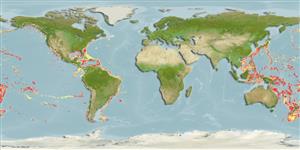>
Gadiformes (Cods) >
Macrouridae (Grenadiers or rattails)
Etymology: Hymenocephalus: Named for its transparent membrane-like head covering (‘‘hymen head’’) and fragile nature of head bones (Ref. 100825).
More on author: Gilbert.
Environment: milieu / climate zone / depth range / distribution range
Sinh thái học
Biển Sống nổi và đáy; Mức độ sâu 340 - 1348 m (Ref. 58302). Deep-water
Widespread but patchy and discontinuous. Atlantic: Caribbean and continental slope of northern South America. Pacific: off subtropical western and eastern Australia, several islands in the southern Pacific (New Caledonia, Vanuatu, Wallis & Futuna, Marquesas Islands), and off Hawaii. Not recorded from eastern Atlantic nor Indian Ocean.
Bộ gần gũi / Khối lượng (Trọng lượng) / Age
Maturity: Lm ? range ? - ? cm
Max length : 20.0 cm TL con đực/không giới tính; (Ref. 37108)
Short description
Hình thái học | Sinh trắc học
This species is distinguished by the following characters: a black-colored large-headed fish, with head size 21-25% TL; pelvic fin rays 13-14; pectoral fin rays 13-16; projecting snout, 20-24% HL; head bones are papery thin and often distorted; no barbel; small orbit diameter, 20-24% HL; interorbital width 60-70% HW; infraorbital width 20-25% HL; postorbital-preopercular interspace 10-14% HL; preopercular supporter is very small and forked; gill rakers 21-25; ventral striae reaching to about ? from pelvic fin bases to periproct; small otolith with rounded outline, no predorsal lobe developed; colliculi separated; otholith length to height (OL:OH), 1.0-1.2; total colliculum length to pseudocolliculum length (TCL:PCL) is 2.2-2.8 (Ref. 98298).
Found on the continental slope (Ref. 75154). Benthopelagic (Ref. 58302).
Life cycle and mating behavior
Chín muồi sinh dục | Sự tái sinh sản | Đẻ trứng | Các trứng | Sự sinh sản | Ấu trùng
Cohen, D.M., A.W. Ebeling, T. Iwamoto, S.B. McDowell, N.B. Marshall, D.E. Rosen, P. Sonoda, W.H. Weed III and L.P. Woods, 1973. Fishes of the western North Atlantic. Part six. New Haven, Sears Found. Mar. Res., Yale Univ. (Ref. 37108)
IUCN Red List Status (Ref. 130435)
Threat to humans
Harmless
Human uses
Thêm thông tin
Age/SizeSự sinh trưởngLength-weightLength-lengthLength-frequenciesSinh trắc họcHình thái họcẤu trùngSự biến động ấu trùngBổ xungSự phong phúBRUVS
Các tài liệu tham khảoNuôi trồng thủy sảnTổng quan nuôi trồng thủy sảnCác giốngDi truyềnElectrophoresesDi sảnCác bệnhChế biếnNutrientsMass conversion
Các công cụ
Special reports
Download XML
Các nguồn internet
Estimates based on models
Preferred temperature (Ref.
123201): 5.1 - 10.2, mean 7.1 °C (based on 622 cells).
Phylogenetic diversity index (Ref.
82804): PD
50 = 0.5000 [Uniqueness, from 0.5 = low to 2.0 = high].
Bayesian length-weight: a=0.00219 (0.00111 - 0.00431), b=3.20 (3.03 - 3.37), in cm total length, based on LWR estimates for this (Sub)family-body shape (Ref.
93245).
Mức dinh dưỡng (Ref.
69278): 3.4 ±0.4 se; based on size and trophs of closest relatives
Thích nghi nhanh (Ref.
120179): Trung bình, thời gian nhân đôi của chủng quần tối thiểu là 1.4 - 4.4 năm (Preliminary K or Fecundity.).
Fishing Vulnerability (Ref.
59153): Low vulnerability (10 of 100).
